Annotated bibliography on managing digital systems in organizations Discussion 2022
VerifiedAdded on 2022/10/18
|11
|1842
|11
AI Summary
Contribute Materials
Your contribution can guide someone’s learning journey. Share your
documents today.

Running head: MANAGEMENT
Annotated bibliography on managing digital systems in organizations
Name of the student:
Name of the university:
Author note:
Annotated bibliography on managing digital systems in organizations
Name of the student:
Name of the university:
Author note:
Secure Best Marks with AI Grader
Need help grading? Try our AI Grader for instant feedback on your assignments.
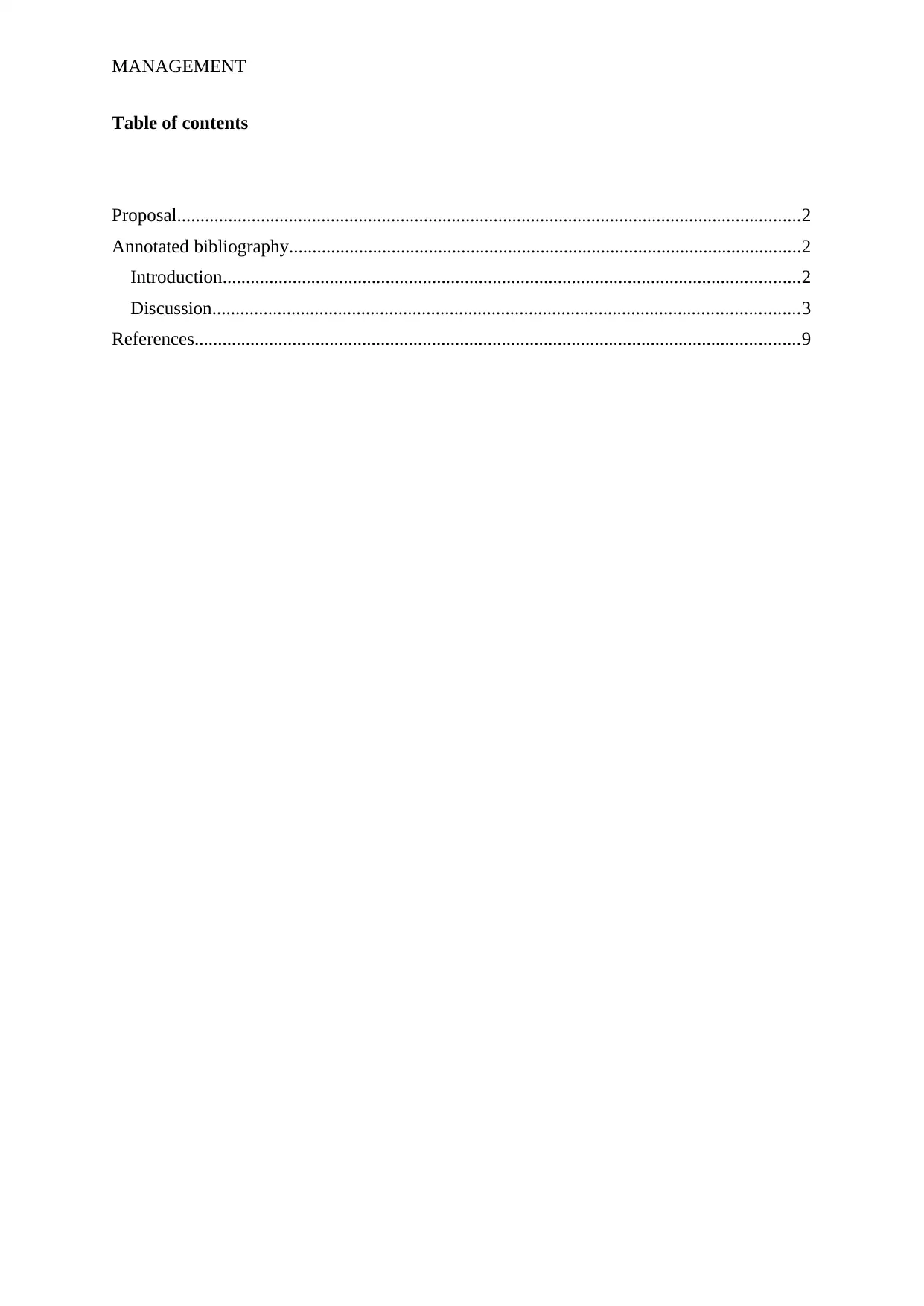
MANAGEMENT
Table of contents
Proposal......................................................................................................................................2
Annotated bibliography..............................................................................................................2
Introduction............................................................................................................................2
Discussion..............................................................................................................................3
References..................................................................................................................................9
Table of contents
Proposal......................................................................................................................................2
Annotated bibliography..............................................................................................................2
Introduction............................................................................................................................2
Discussion..............................................................................................................................3
References..................................................................................................................................9

MANAGEMENT
Proposal
Project overview Digitalization is assistance for the companies and organizations in
terms of radically transforming the workplace conditions. Research
and development team plays an important role in automatizing the
business operations through the collaboration with the engineers. This
proposal would shed light on the approaches of the personnel of Nestle
towards achieving digital transformation in the workplace.
Project goals To assess the systems used by the food and beverage industries
to process the food items
To examine the security measures used by the food and
beverage industries for enhancing the privacy of the
confidential data
To investigate the flexibility of the machines and systems
towards catering to the health issues of the customers
To propose recommendations for upgrading the standards and
quality of the systems, so that the staffs of the food and
beverage industry can prepare healthy food products
Specifications The stakeholders of this project would be the brands intending to
acquire machines, which are effective for malt extraction.
Milestones The project would be effective in terms of reducing the obesity rates,
diabetes level among others.
Annotated bibliography
Introduction
Digitalization is needed in the present competitive ambience. This is in terms of
competing with the contemporary brands in terms of achieving customer satisfaction.
Proposal
Project overview Digitalization is assistance for the companies and organizations in
terms of radically transforming the workplace conditions. Research
and development team plays an important role in automatizing the
business operations through the collaboration with the engineers. This
proposal would shed light on the approaches of the personnel of Nestle
towards achieving digital transformation in the workplace.
Project goals To assess the systems used by the food and beverage industries
to process the food items
To examine the security measures used by the food and
beverage industries for enhancing the privacy of the
confidential data
To investigate the flexibility of the machines and systems
towards catering to the health issues of the customers
To propose recommendations for upgrading the standards and
quality of the systems, so that the staffs of the food and
beverage industry can prepare healthy food products
Specifications The stakeholders of this project would be the brands intending to
acquire machines, which are effective for malt extraction.
Milestones The project would be effective in terms of reducing the obesity rates,
diabetes level among others.
Annotated bibliography
Introduction
Digitalization is needed in the present competitive ambience. This is in terms of
competing with the contemporary brands in terms of achieving customer satisfaction.
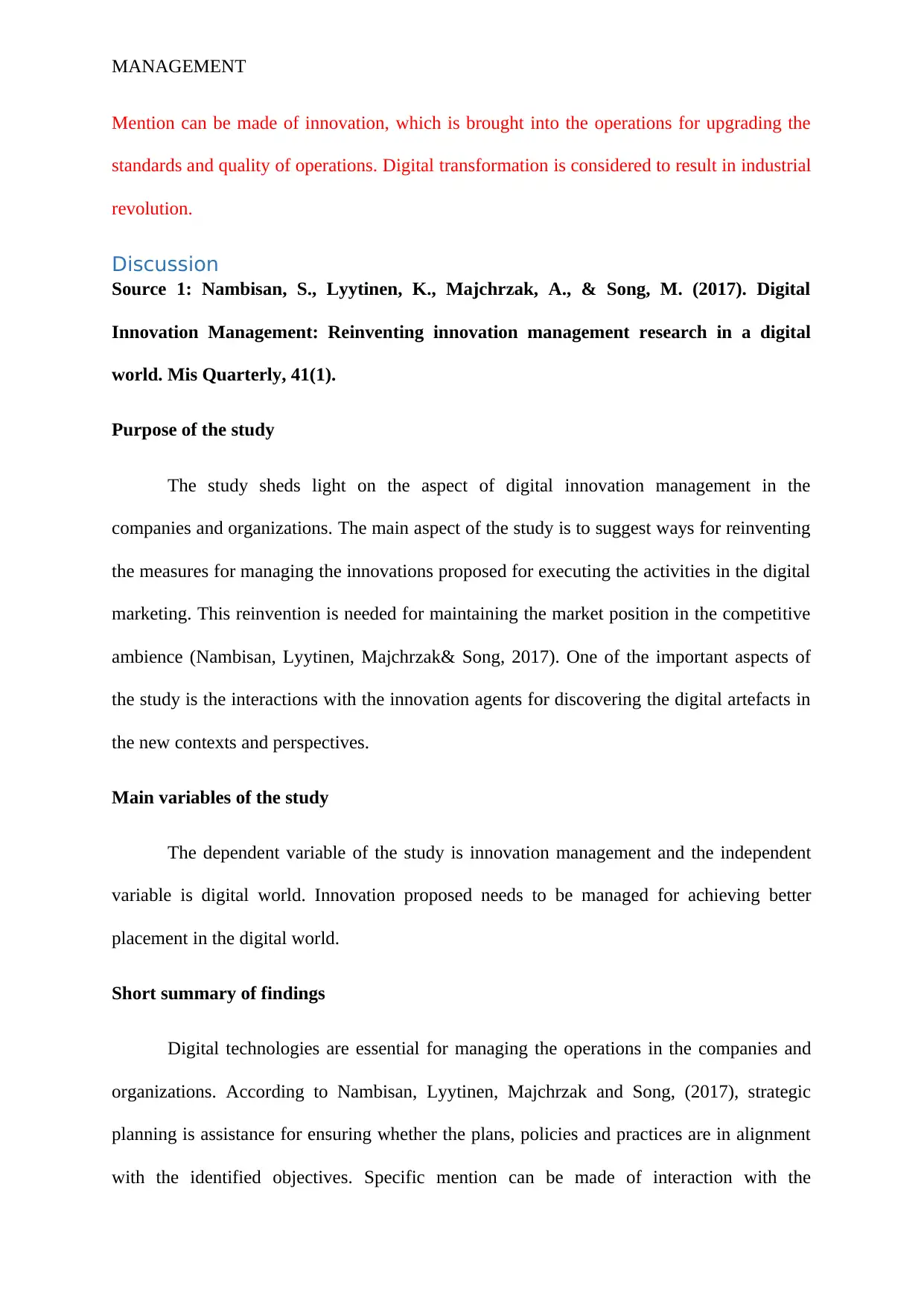
MANAGEMENT
Mention can be made of innovation, which is brought into the operations for upgrading the
standards and quality of operations. Digital transformation is considered to result in industrial
revolution.
Discussion
Source 1: Nambisan, S., Lyytinen, K., Majchrzak, A., & Song, M. (2017). Digital
Innovation Management: Reinventing innovation management research in a digital
world. Mis Quarterly, 41(1).
Purpose of the study
The study sheds light on the aspect of digital innovation management in the
companies and organizations. The main aspect of the study is to suggest ways for reinventing
the measures for managing the innovations proposed for executing the activities in the digital
marketing. This reinvention is needed for maintaining the market position in the competitive
ambience (Nambisan, Lyytinen, Majchrzak& Song, 2017). One of the important aspects of
the study is the interactions with the innovation agents for discovering the digital artefacts in
the new contexts and perspectives.
Main variables of the study
The dependent variable of the study is innovation management and the independent
variable is digital world. Innovation proposed needs to be managed for achieving better
placement in the digital world.
Short summary of findings
Digital technologies are essential for managing the operations in the companies and
organizations. According to Nambisan, Lyytinen, Majchrzak and Song, (2017), strategic
planning is assistance for ensuring whether the plans, policies and practices are in alignment
with the identified objectives. Specific mention can be made of interaction with the
Mention can be made of innovation, which is brought into the operations for upgrading the
standards and quality of operations. Digital transformation is considered to result in industrial
revolution.
Discussion
Source 1: Nambisan, S., Lyytinen, K., Majchrzak, A., & Song, M. (2017). Digital
Innovation Management: Reinventing innovation management research in a digital
world. Mis Quarterly, 41(1).
Purpose of the study
The study sheds light on the aspect of digital innovation management in the
companies and organizations. The main aspect of the study is to suggest ways for reinventing
the measures for managing the innovations proposed for executing the activities in the digital
marketing. This reinvention is needed for maintaining the market position in the competitive
ambience (Nambisan, Lyytinen, Majchrzak& Song, 2017). One of the important aspects of
the study is the interactions with the innovation agents for discovering the digital artefacts in
the new contexts and perspectives.
Main variables of the study
The dependent variable of the study is innovation management and the independent
variable is digital world. Innovation proposed needs to be managed for achieving better
placement in the digital world.
Short summary of findings
Digital technologies are essential for managing the operations in the companies and
organizations. According to Nambisan, Lyytinen, Majchrzak and Song, (2017), strategic
planning is assistance for ensuring whether the plans, policies and practices are in alignment
with the identified objectives. Specific mention can be made of interaction with the
Secure Best Marks with AI Grader
Need help grading? Try our AI Grader for instant feedback on your assignments.
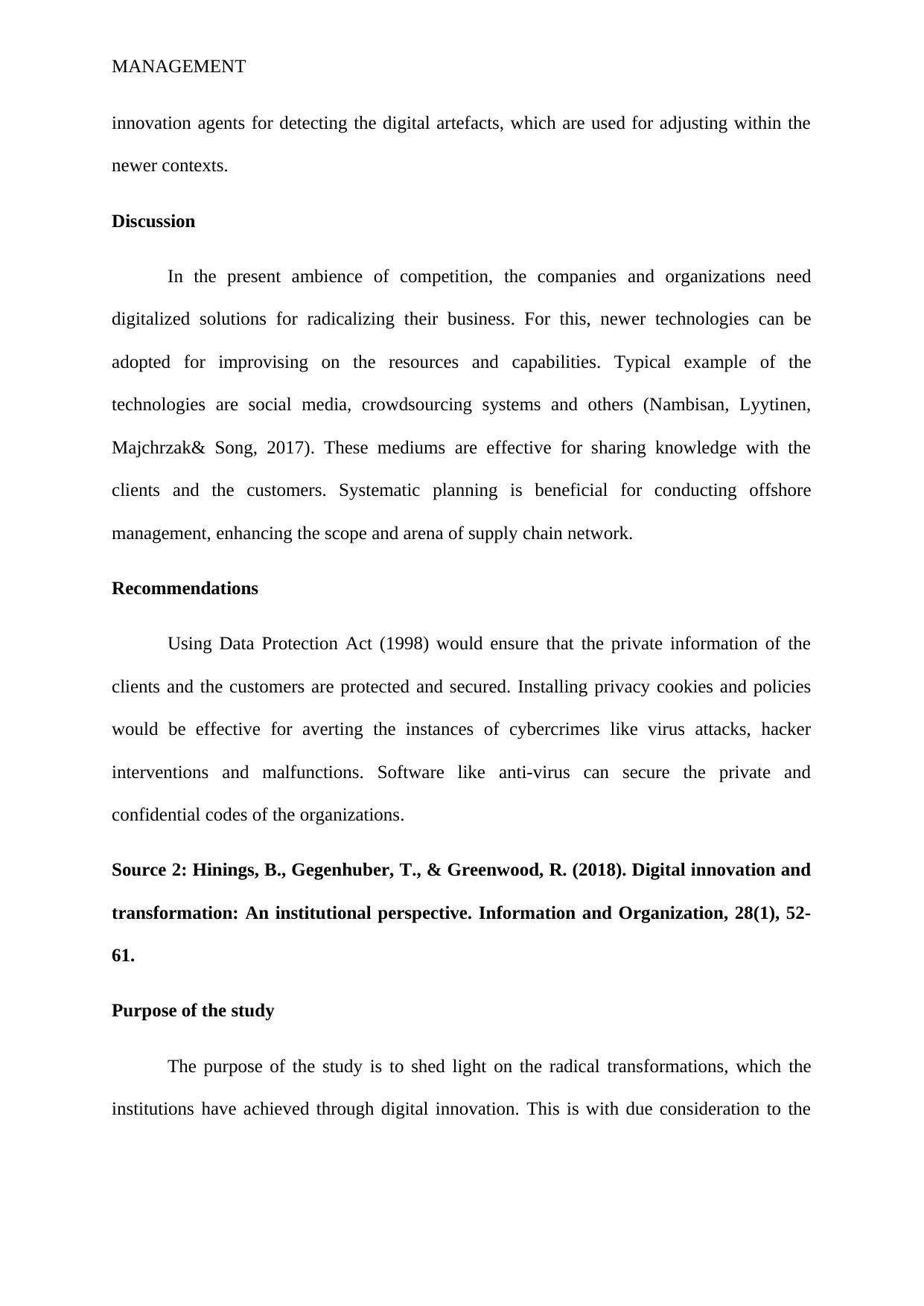
MANAGEMENT
innovation agents for detecting the digital artefacts, which are used for adjusting within the
newer contexts.
Discussion
In the present ambience of competition, the companies and organizations need
digitalized solutions for radicalizing their business. For this, newer technologies can be
adopted for improvising on the resources and capabilities. Typical example of the
technologies are social media, crowdsourcing systems and others (Nambisan, Lyytinen,
Majchrzak& Song, 2017). These mediums are effective for sharing knowledge with the
clients and the customers. Systematic planning is beneficial for conducting offshore
management, enhancing the scope and arena of supply chain network.
Recommendations
Using Data Protection Act (1998) would ensure that the private information of the
clients and the customers are protected and secured. Installing privacy cookies and policies
would be effective for averting the instances of cybercrimes like virus attacks, hacker
interventions and malfunctions. Software like anti-virus can secure the private and
confidential codes of the organizations.
Source 2: Hinings, B., Gegenhuber, T., & Greenwood, R. (2018). Digital innovation and
transformation: An institutional perspective. Information and Organization, 28(1), 52-
61.
Purpose of the study
The purpose of the study is to shed light on the radical transformations, which the
institutions have achieved through digital innovation. This is with due consideration to the
innovation agents for detecting the digital artefacts, which are used for adjusting within the
newer contexts.
Discussion
In the present ambience of competition, the companies and organizations need
digitalized solutions for radicalizing their business. For this, newer technologies can be
adopted for improvising on the resources and capabilities. Typical example of the
technologies are social media, crowdsourcing systems and others (Nambisan, Lyytinen,
Majchrzak& Song, 2017). These mediums are effective for sharing knowledge with the
clients and the customers. Systematic planning is beneficial for conducting offshore
management, enhancing the scope and arena of supply chain network.
Recommendations
Using Data Protection Act (1998) would ensure that the private information of the
clients and the customers are protected and secured. Installing privacy cookies and policies
would be effective for averting the instances of cybercrimes like virus attacks, hacker
interventions and malfunctions. Software like anti-virus can secure the private and
confidential codes of the organizations.
Source 2: Hinings, B., Gegenhuber, T., & Greenwood, R. (2018). Digital innovation and
transformation: An institutional perspective. Information and Organization, 28(1), 52-
61.
Purpose of the study
The purpose of the study is to shed light on the radical transformations, which the
institutions have achieved through digital innovation. This is with due consideration to the
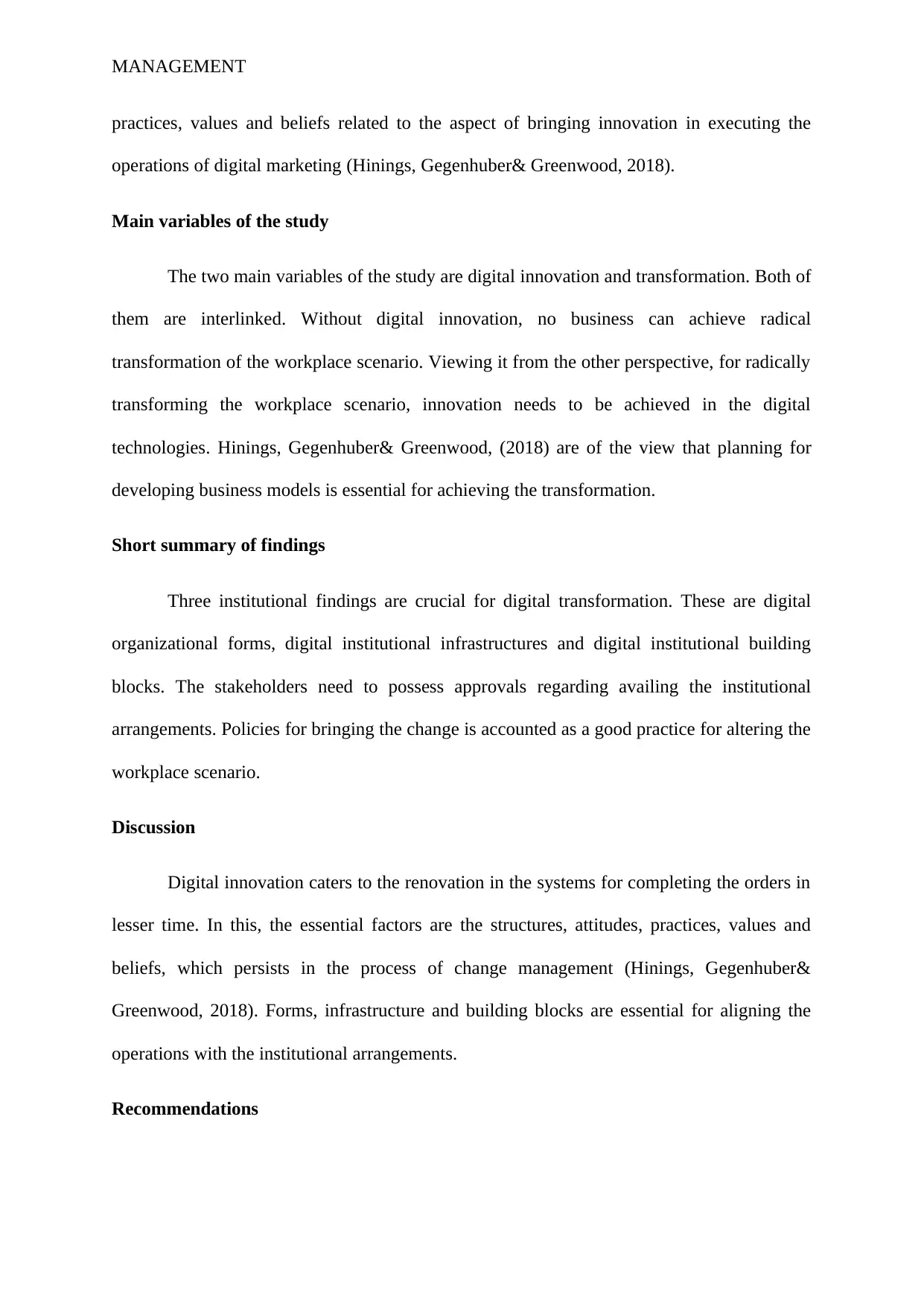
MANAGEMENT
practices, values and beliefs related to the aspect of bringing innovation in executing the
operations of digital marketing (Hinings, Gegenhuber& Greenwood, 2018).
Main variables of the study
The two main variables of the study are digital innovation and transformation. Both of
them are interlinked. Without digital innovation, no business can achieve radical
transformation of the workplace scenario. Viewing it from the other perspective, for radically
transforming the workplace scenario, innovation needs to be achieved in the digital
technologies. Hinings, Gegenhuber& Greenwood, (2018) are of the view that planning for
developing business models is essential for achieving the transformation.
Short summary of findings
Three institutional findings are crucial for digital transformation. These are digital
organizational forms, digital institutional infrastructures and digital institutional building
blocks. The stakeholders need to possess approvals regarding availing the institutional
arrangements. Policies for bringing the change is accounted as a good practice for altering the
workplace scenario.
Discussion
Digital innovation caters to the renovation in the systems for completing the orders in
lesser time. In this, the essential factors are the structures, attitudes, practices, values and
beliefs, which persists in the process of change management (Hinings, Gegenhuber&
Greenwood, 2018). Forms, infrastructure and building blocks are essential for aligning the
operations with the institutional arrangements.
Recommendations
practices, values and beliefs related to the aspect of bringing innovation in executing the
operations of digital marketing (Hinings, Gegenhuber& Greenwood, 2018).
Main variables of the study
The two main variables of the study are digital innovation and transformation. Both of
them are interlinked. Without digital innovation, no business can achieve radical
transformation of the workplace scenario. Viewing it from the other perspective, for radically
transforming the workplace scenario, innovation needs to be achieved in the digital
technologies. Hinings, Gegenhuber& Greenwood, (2018) are of the view that planning for
developing business models is essential for achieving the transformation.
Short summary of findings
Three institutional findings are crucial for digital transformation. These are digital
organizational forms, digital institutional infrastructures and digital institutional building
blocks. The stakeholders need to possess approvals regarding availing the institutional
arrangements. Policies for bringing the change is accounted as a good practice for altering the
workplace scenario.
Discussion
Digital innovation caters to the renovation in the systems for completing the orders in
lesser time. In this, the essential factors are the structures, attitudes, practices, values and
beliefs, which persists in the process of change management (Hinings, Gegenhuber&
Greenwood, 2018). Forms, infrastructure and building blocks are essential for aligning the
operations with the institutional arrangements.
Recommendations

MANAGEMENT
Meetings and audits are needed for making change management plans. Involvement
of the managers and board panel is necessary for ensuring for developing quality policies for
managing the change in terms of altering the standards and quality of the technologies.
Source 3: Grieves, M., & Vickers, J. (2017). Digital twin: Mitigating unpredictable,
undesirable emergent behavior in complex systems. In Transdisciplinary perspectives
on complex systems (pp. 85-113). Springer, Cham.
Purpose of the study
The study enhances the awareness of the readers regarding the lifecycle phases of
creation, production, operations and disposal. In this process, the emergent behaviour is
undertaken for mapping the obstacles in the interaction between the technologies and humans
(Grieves & Vickers, 2017). The concept of digital twin is introduced for gaining an insight
into the application into the product lifecycle and system behaviour.
Main variables of the study
The main variables of the study are digital twin, mitigating unpredictable, undesirable
emergent behaviour and complex systems.
Short summary of findings
Digital Twins are applicable in the process of developing the life cycles and
predicting the system behaviour. System engineering discipline is considered for mapping the
scope and arena in which the interactions takes place between the humans and the
technologies. Within this, Grieves and Vickers, (2017) highlights ‘normal accidents’ are
preferred for gaining an insight into the ways of resolving these issues.
Discussion
Meetings and audits are needed for making change management plans. Involvement
of the managers and board panel is necessary for ensuring for developing quality policies for
managing the change in terms of altering the standards and quality of the technologies.
Source 3: Grieves, M., & Vickers, J. (2017). Digital twin: Mitigating unpredictable,
undesirable emergent behavior in complex systems. In Transdisciplinary perspectives
on complex systems (pp. 85-113). Springer, Cham.
Purpose of the study
The study enhances the awareness of the readers regarding the lifecycle phases of
creation, production, operations and disposal. In this process, the emergent behaviour is
undertaken for mapping the obstacles in the interaction between the technologies and humans
(Grieves & Vickers, 2017). The concept of digital twin is introduced for gaining an insight
into the application into the product lifecycle and system behaviour.
Main variables of the study
The main variables of the study are digital twin, mitigating unpredictable, undesirable
emergent behaviour and complex systems.
Short summary of findings
Digital Twins are applicable in the process of developing the life cycles and
predicting the system behaviour. System engineering discipline is considered for mapping the
scope and arena in which the interactions takes place between the humans and the
technologies. Within this, Grieves and Vickers, (2017) highlights ‘normal accidents’ are
preferred for gaining an insight into the ways of resolving these issues.
Discussion
Paraphrase This Document
Need a fresh take? Get an instant paraphrase of this document with our AI Paraphraser
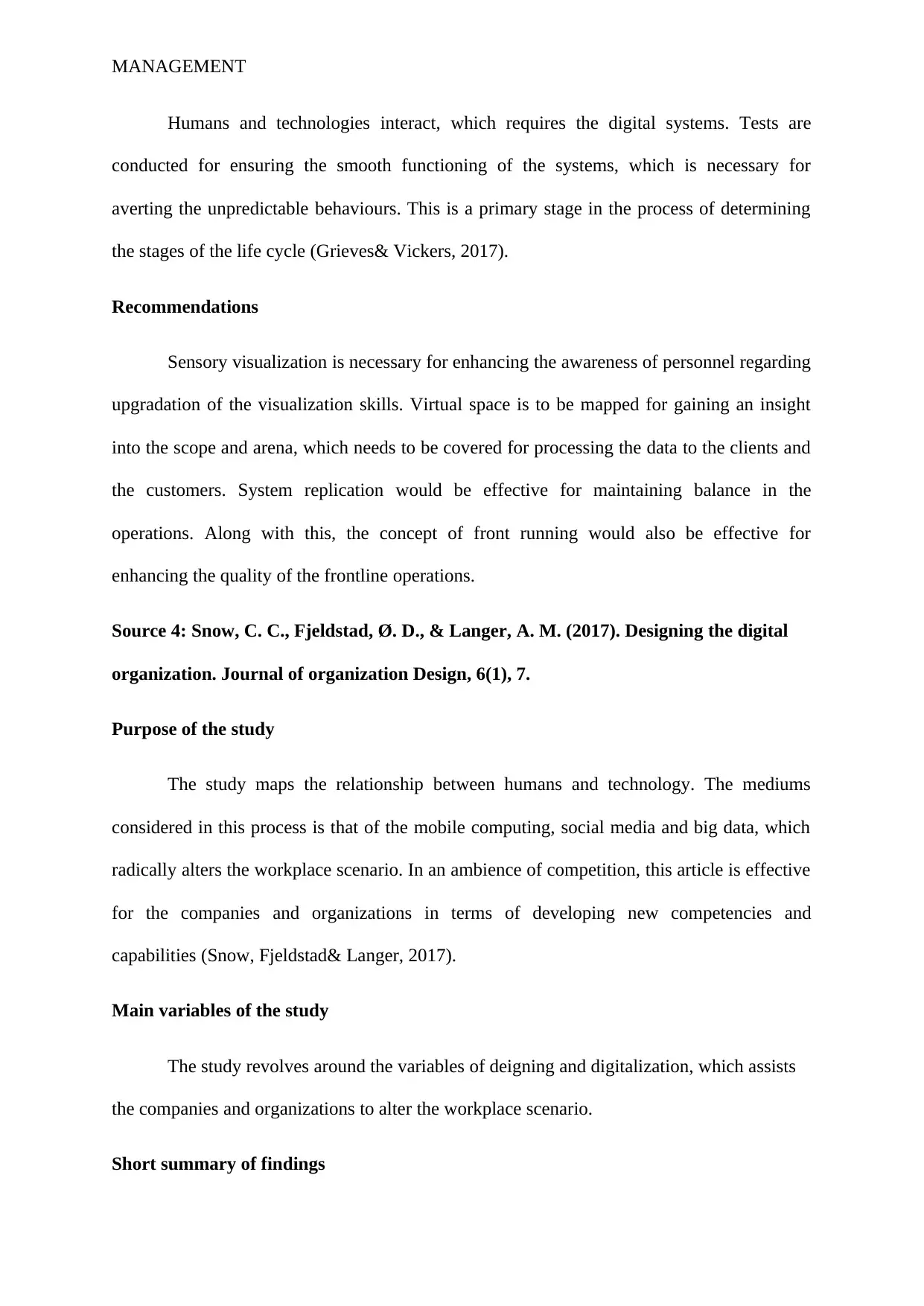
MANAGEMENT
Humans and technologies interact, which requires the digital systems. Tests are
conducted for ensuring the smooth functioning of the systems, which is necessary for
averting the unpredictable behaviours. This is a primary stage in the process of determining
the stages of the life cycle (Grieves& Vickers, 2017).
Recommendations
Sensory visualization is necessary for enhancing the awareness of personnel regarding
upgradation of the visualization skills. Virtual space is to be mapped for gaining an insight
into the scope and arena, which needs to be covered for processing the data to the clients and
the customers. System replication would be effective for maintaining balance in the
operations. Along with this, the concept of front running would also be effective for
enhancing the quality of the frontline operations.
Source 4: Snow, C. C., Fjeldstad, Ø. D., & Langer, A. M. (2017). Designing the digital
organization. Journal of organization Design, 6(1), 7.
Purpose of the study
The study maps the relationship between humans and technology. The mediums
considered in this process is that of the mobile computing, social media and big data, which
radically alters the workplace scenario. In an ambience of competition, this article is effective
for the companies and organizations in terms of developing new competencies and
capabilities (Snow, Fjeldstad& Langer, 2017).
Main variables of the study
The study revolves around the variables of deigning and digitalization, which assists
the companies and organizations to alter the workplace scenario.
Short summary of findings
Humans and technologies interact, which requires the digital systems. Tests are
conducted for ensuring the smooth functioning of the systems, which is necessary for
averting the unpredictable behaviours. This is a primary stage in the process of determining
the stages of the life cycle (Grieves& Vickers, 2017).
Recommendations
Sensory visualization is necessary for enhancing the awareness of personnel regarding
upgradation of the visualization skills. Virtual space is to be mapped for gaining an insight
into the scope and arena, which needs to be covered for processing the data to the clients and
the customers. System replication would be effective for maintaining balance in the
operations. Along with this, the concept of front running would also be effective for
enhancing the quality of the frontline operations.
Source 4: Snow, C. C., Fjeldstad, Ø. D., & Langer, A. M. (2017). Designing the digital
organization. Journal of organization Design, 6(1), 7.
Purpose of the study
The study maps the relationship between humans and technology. The mediums
considered in this process is that of the mobile computing, social media and big data, which
radically alters the workplace scenario. In an ambience of competition, this article is effective
for the companies and organizations in terms of developing new competencies and
capabilities (Snow, Fjeldstad& Langer, 2017).
Main variables of the study
The study revolves around the variables of deigning and digitalization, which assists
the companies and organizations to alter the workplace scenario.
Short summary of findings
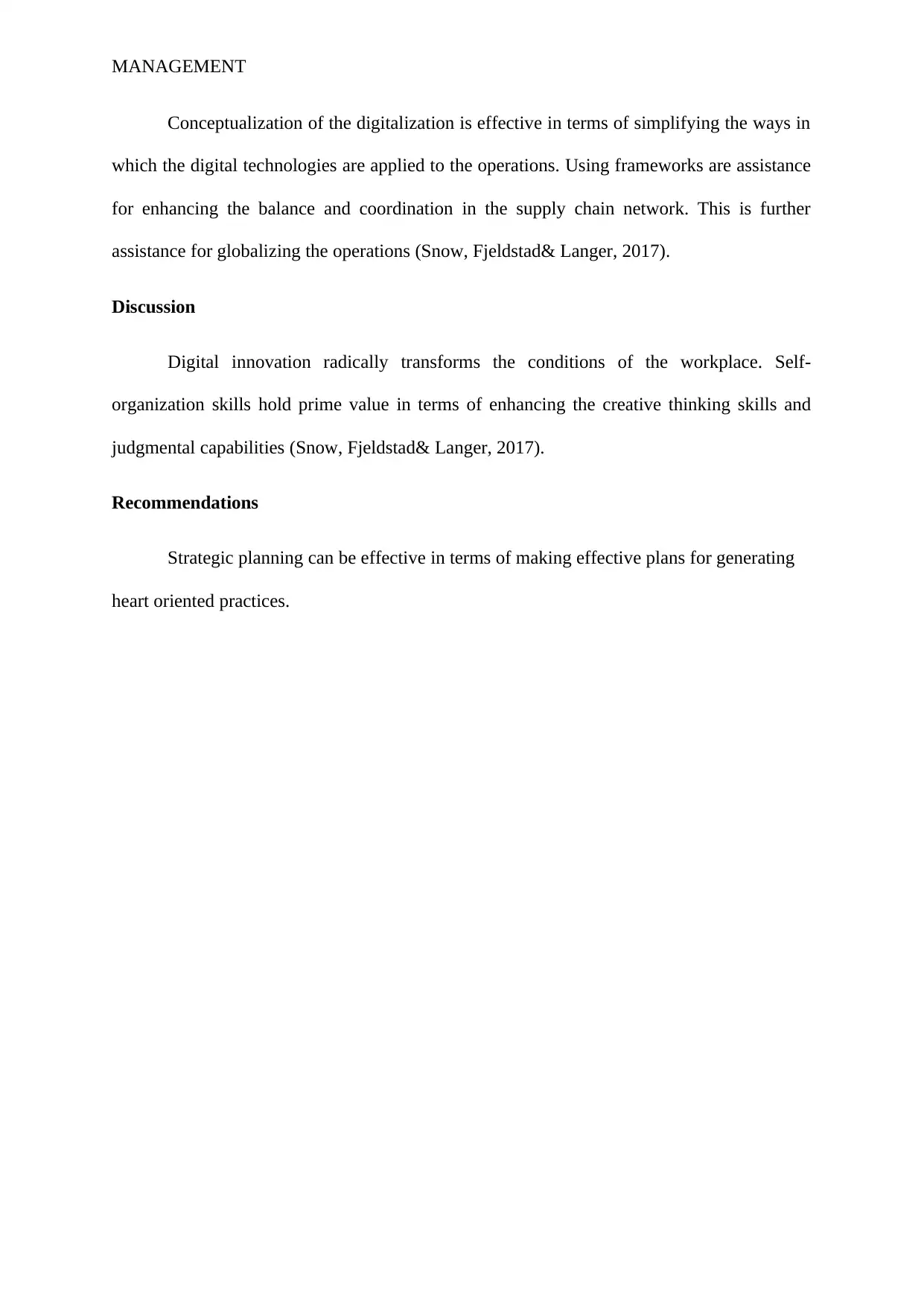
MANAGEMENT
Conceptualization of the digitalization is effective in terms of simplifying the ways in
which the digital technologies are applied to the operations. Using frameworks are assistance
for enhancing the balance and coordination in the supply chain network. This is further
assistance for globalizing the operations (Snow, Fjeldstad& Langer, 2017).
Discussion
Digital innovation radically transforms the conditions of the workplace. Self-
organization skills hold prime value in terms of enhancing the creative thinking skills and
judgmental capabilities (Snow, Fjeldstad& Langer, 2017).
Recommendations
Strategic planning can be effective in terms of making effective plans for generating
heart oriented practices.
Conceptualization of the digitalization is effective in terms of simplifying the ways in
which the digital technologies are applied to the operations. Using frameworks are assistance
for enhancing the balance and coordination in the supply chain network. This is further
assistance for globalizing the operations (Snow, Fjeldstad& Langer, 2017).
Discussion
Digital innovation radically transforms the conditions of the workplace. Self-
organization skills hold prime value in terms of enhancing the creative thinking skills and
judgmental capabilities (Snow, Fjeldstad& Langer, 2017).
Recommendations
Strategic planning can be effective in terms of making effective plans for generating
heart oriented practices.

MANAGEMENT
References
Grieves, M., & Vickers, J. (2017). Digital twin: Mitigating unpredictable, undesirable
emergent behavior in complex systems. In Transdisciplinary perspectives on complex
systems (pp. 85-113). Springer, Cham.
Hinings, B., Gegenhuber, T., & Greenwood, R. (2018). Digital innovation and
transformation: An institutional perspective. Information and Organization, 28(1), 52-
61.
Nambisan, S., Lyytinen, K., Majchrzak, A., & Song, M. (2017). Digital Innovation
Management: Reinventing innovation management research in a digital world. Mis
Quarterly, 41(1).
Snow, C. C., Fjeldstad, Ø. D., & Langer, A. M. (2017). Designing the digital organization.
Journal of organization Design, 6(1), 7.
References
Grieves, M., & Vickers, J. (2017). Digital twin: Mitigating unpredictable, undesirable
emergent behavior in complex systems. In Transdisciplinary perspectives on complex
systems (pp. 85-113). Springer, Cham.
Hinings, B., Gegenhuber, T., & Greenwood, R. (2018). Digital innovation and
transformation: An institutional perspective. Information and Organization, 28(1), 52-
61.
Nambisan, S., Lyytinen, K., Majchrzak, A., & Song, M. (2017). Digital Innovation
Management: Reinventing innovation management research in a digital world. Mis
Quarterly, 41(1).
Snow, C. C., Fjeldstad, Ø. D., & Langer, A. M. (2017). Designing the digital organization.
Journal of organization Design, 6(1), 7.
Secure Best Marks with AI Grader
Need help grading? Try our AI Grader for instant feedback on your assignments.

MANAGEMENT
1 out of 11
Your All-in-One AI-Powered Toolkit for Academic Success.
+13062052269
info@desklib.com
Available 24*7 on WhatsApp / Email
![[object Object]](/_next/static/media/star-bottom.7253800d.svg)
Unlock your academic potential
© 2024 | Zucol Services PVT LTD | All rights reserved.
